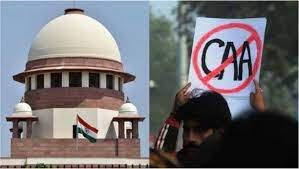
In a momentous stride for the Indian legal tapestry, a Constitution Bench led by Chief Justice D Y Chandrachud has commenced an exhaustive examination of the constitutional validity of Section 6A of the Citizenship Act, 1956. This pivotal provision, intricately woven into the fabric of the Assam Accord, has become the epicenter of legal scrutiny and public discourse. Within the venerable halls of the Supreme Court, the hearings have unfurled a rich tapestry interwoven with legal intricacies, political considerations, and humanitarian imperatives.
Contextualizing the Complexity: Assam Accord and Section 6A
To fathom the gravity of the ongoing proceedings, it is imperative to plunge into the historical undercurrents that birthed Section 6A. The provision traces its lineage to the Assam Accord, a seminal agreement born amid the tumultuous aftermath of the Bangladesh Liberation War. Forged in 1985, the accord aimed to grapple with the intricate challenge of immigration in the state of Assam.
The Essence of Section 6A: A Delicate Equilibrium
Section 6A of the Citizenship Act, 1956, materialized as a legislative embodiment of the delicate equilibrium envisioned by the architects of the Assam Accord. This provision extends a pathway to Indian citizenship for foreign migrants who crossed the border before 1971. Originally crafted to address the humanitarian facets of displacement, Section 6A now finds itself under the judicial microscope, with litigants challenging its constitutional sanctity.
Constitutional Bench Convenes: A Judicial Odyssey Unfolds
The stage for this legal drama was set when a Constitution Bench, comprising five distinguished judges, convened on December 5, 2023. Chief Justice D Y Chandrachud, at the helm, shoulders the responsibility of guiding the judiciary through the labyrinthine maze of constitutional law, migration policy, and the rights of indigenous populations.
Myriad Perspectives Unveiled through Petitions
The crux of the matter lies in the plethora of petitions challenging Section 6A. These legal documents, representing a panorama of perspectives, bring forth an array of concerns. Petitioners posit that if not judiciously implemented, the provision could imperil the demographic integrity of Assam, potentially marginalizing indigenous communities into minorities in their own homeland.
Government’s Plea for Latitude: A Pragmatic Lens?
In a notable turn of events, the Supreme Court has acknowledged the government’s plea for latitude in interpreting and implementing Section 6A. Throughout the hearings, the court emphasized the necessity to afford the government the flexibility needed to make essential adjustments in the interest of the nation. This acknowledgment injects a pragmatic dimension into the legal discourse, recognizing the exigencies of governance and the state’s duty to safeguard national interests.
Chief Justice’s Steadfast Leadership: A Guiding Light of Objectivity

At the forefront of this judicial odyssey stands Chief Justice D.Y. Chandrachud, whose leadership serves as a beacon of objectivity and impartiality. His discerning guidance ensures that the proceedings navigate the intricate terrain of legal arguments while remaining anchored to the fundamental principles of justice and constitutional validity. The Chief Justice’s stewardship instills confidence in the public that the case is in capable hands.
Petitioners’ Struggle: Upholding Rights and Identities
For the petitioners, the struggle transcends mere legalities; it is a battle for the preservation of identities, cultures, and the very essence of communities deeply entrenched in the annals of Assam’s history. Their arguments resonate with a sense of urgency, contending that Section 6A, if not meticulously scrutinized, could irreversibly alter the demographic landscape.
Official Data Inquiry: Grounding Legal Discourse in Realities
The Supreme Court’s insistence on official data regarding the beneficiaries of Section 6A adds a pivotal layer to the proceedings. This inquiry seeks to anchor the legal discourse in concrete realities, shifting the focus from abstract legal arguments to the tangible impact of the provision on individuals and communities. It underscores the court’s commitment to an evidence-based approach in adjudicating this intricate matter.
National Ramifications: A Legal Template Beyond Assam
While the epicenter of these hearings is Assam, the ramifications extend far beyond the borders of this northeastern state. The decisions stemming from this legal crucible are poised to establish crucial precedents in the interpretation of citizenship laws at a national level. The nuanced balancing act demanded in the context of Assam may well become a template for addressing analogous issues across the country.
Public Interest: A Nation Watches with Bated Breath
The proceedings have not escaped the notice of the public. As the legal drama unfolds, citizens, scholars, activists, and legal experts alike watch with bated breath. The case’s public interest underscores its weight in shaping the trajectory of citizenship laws and policies in India.
Ongoing Deliberations: A Continuing Legal Saga
As of the latest update, the hearings persist, with legal luminaries presenting their arguments and counter-arguments. The Constitution Bench meticulously sifts through the legal intricacies, cognizant that its decisions will reverberate far beyond the courtroom. This ongoing legal saga underscores the judiciary’s commitment to due process, thorough examination, and the principles that underpin the fabric of the Indian Constitution.
Conclusion: Navigating Complexity with Surgical Precision

In conclusion, the Constitution Bench’s hearings on Section 6A of the Citizenship Act, of 1956, exemplify meticulous navigation through a complex tapestry of legal, historical, and humanitarian considerations. As the proceedings unfold, the nation awaits the verdict, mindful that the decisions emerging from this crucible will shape the contours of citizenship law and policy in India.
In the delicate dance between the Assam Accord’s humanitarian spirit and the imperative to protect local interests, the judiciary treads with surgical precision, recognizing the gravity of the decisions at hand. The Constitution Bench’s role in this legal drama is pivotal, and its verdict will echo through the corridors of Indian jurisprudence for years to come.











Comments 2